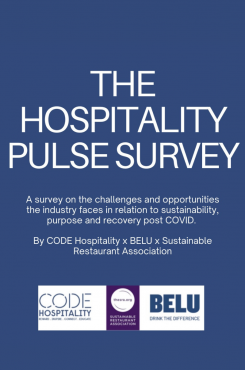How to tackle rising energy costs sustainably
Published 25 May 2022
sponsored content in collaboration with the Sustainable Restaurant Association

It’s an indictment of the state of the economy right now that when, earlier this month, the Bank of England predicted inflation was set to rise to 10% by the end of the year, it really didn’t seem that shocking. Anyone running a restaurant right now would bite your hand off if you offered them an increase of only 10% across the board, as the reality many are facing is considerably more dire.
Those of us in the industry barely need reminding of all the different cost pressure points, but we’ll briefly mention the big three: soaring energy bills, skyrocketing food prices and wage increases not seen in decades.
Just as there was no guide for surviving the pandemic, there was nothing to prepare restaurateurs for this tsunami of soaring costs.
Though the intensity of inflationary pressure at the moment is extreme, heightened by the war in Ukraine and continued COVID consequences, the reality is that due to the climate crisis, volatility may very well be here to stay for the foreseeable future. The Sustainable Restaurant (SRA) is an organisation committed to driving the hospitality sector further and faster towards a future that is good for people and the planet.
Over the course of a three-part series, we will demonstrate that now is the time to future-proof your business, investing in initiatives that not only offer opportunities to ease the financial burden you’re feeling, but also reduce the restaurant’s impact on the environment while having a positive effect on the workforce.
A conversation with the founder of a smallish, food-led pub group put everything into perspective this week. In January 2021 he signed up to a fixed tariff for three years. He’s insulated against the runaway rises, for the time being at least. He reflected that, left to market forces, his predicted £1.5m profit would be wiped out.
A study by energy analysts Cornwall Insight found that gas prices paid by small and medium-sized businesses in the first three months of 2022 were 250% higher than in the same period in 2021.
The sector’s energy costs were high enough already before this crisis – a combined annual bill of more than £1.3 billion, with carbon emissions of 8 million tonnes. UK Power estimates that 5% of a restaurant’s total expenditure can be spent on gas and electricity. And that’s increasing.
Cooking accounts for about two thirds of the average restaurant’s gas usage. Is it really essential? Sure, chefs love the fire and brimstone of those big burners, but what if there was an alternative that was more efficient and created a working environment that was far more comfortable? Perhaps you’ve thought about induction but ruled it out on the basis that it’s way too expensive and will take years to claw back the return on investment. That’s where it might just pay to take advantage of this crisis.
With gas prices more than twice what they were a year ago, the ROI period is halved. Now is the time to make the switch — your bills, your team and the environment will thank you.
One chef/restaurateur who’s taken the plunge is Neil Forbes of Cafe St Honore in Edinburgh – with no regrets. In fact, despite the £12,000 outlay, he’s thrilled.
“I was basically burning £5 notes every service. The burners were on from 9 ‘til 2.30 and then again from 5 ‘til 10. The chefs were dripping in sweat, we were chucking fumes up the chimney and the extractors were working overtime. I’m chained to the stove four days a week and the difference in the working day is astonishing. The efficiency is extraordinary, we’ve got a nice, cool environment to work in and it’s saving us money.”
For those still hesitating because of the chunky initial outlay, there’s a further incentive that might just persuade you, although you might want to enlist the help of your accountant. For expenditure incurred from 1 April 2021 until the end of March 2023, companies can claim 130% capital allowances on qualifying plant and machinery investments. Under the super-deduction, for every pound a company invests, their taxes are cut by up to 25p. Find out more about this opportunity here.
Keith Warren of the Foodservice Equipment Association (FEA) suggests that for those still wary of the capital expense, there are an increasing range of options for leasing.
“There’s a lot to be said for kitchen envy,” adds Keith. “By creating a kitchen that chefs want to work in, you’ll be attracting staff and retaining them better. Instead of spending the end of the shift chipping burnt carbon off the range, they’ll just be wiping down.”
For those for whom any capital outlay is not a viable option, there are plenty of other steps to take to slash bills and reduce the carbon footprint. Listening to the FEA’s carbon and cost saving podcast is an excellent place to start.
In terms of specifics, here are a few pointers:
Clean up
The Carbon Trust estimates that 20% of energy costs are wasted through inefficient equipment. Fridges with dirty filters can use 25% more energy than when new, and heavily scaled heating elements can use 50% more energy, and considerably more time, to reach temperature.
Answer? Give your key items of equipment a clean and service.
Stay smart
Do you know what are your biggest gas and electricity guzzlers?
If not, then fit smart meters. They need not be an expensive investment: your energy provider can help you have smart meters installed at your business and will set you up with online energy monitoring software as part of your contract.
Empower your team
By engaging the team – simply by sharing the bills, providing them with some basic behaviour changes and incentivising them to come up with energy and cost-cutting measures – you’ll create a more motivated team.
Swich on
If you haven’t yet swapped your conventional lightbulbs to CFLs, what are you waiting for? They use 75% less electricity than their standard counterparts.
Go green
For a cost-neutral move that will have a seriously positive impact on a restaurant’s carbon footprint, there aren’t many that match switching to a 100% renewable energy tariff. In fact, when we calculated the effect with a London restaurant that completed our Net Zero Restaurant initiative, the carbon saving was a whopping 600 tonnes a year.
So, hopefully these are some ideas for helping you navigate the next few months while energy prices stay hot, and beyond. Check back in two weeks as we assess how best you can address the ongoing challenge of recruitment and rising staff costs.
Through our Food Made Good programme, we define, assesses and celebrate sustainability, as well as connect a global network of hospitality professionals to share challenges, ideas, resources and solutions. If you’d like sustainability advice for your restaurant, we’d love to hear from you. Find out more about the SRA and its Food Made Good programme. Or get in touch [email protected]
Sponsored content in collaboration with the SRA. To read similar articles click here





